Clerodendrum Thompson - Home Care
Thompson's Clodendrum is one of the finest plants that can be grown at home. What is the difference between this fast-growing liana and what are the rules for caring for it at home, let's look.
Botanical Description
In the natural environment, the liana grows up to 4 meters in length, in domestic - up to two. The plant is characterized by long flowering, up to 6 months, starting from March - April and ending with September - October.

Characteristics of Clerodendrum Thompson:
| Stem | Curly, woody liana |
| Leaf shape | Oval, grooved along the veins, up to 12 cm in length |
| Leaf color | Green |
| Flower shape | Bracts - in the form of inverted cups or bells with a diameter of up to 3 cm. Flowers - in the form of a five-lobed corolla with stamens |
| Flower color | Bracts are white, turn pink over time, turn purple; the flowers are bright red, with time they become dark cherry |
| Fruit shape | Oval, length about 1 cm |
| Fruit color | Orange |
House growing conditions
Growing at home involves observing the temperature and humidity conditions, as well as the correct location.
Location
In the natural habitat, Thompson's Clodendrum grows under the crowns of trees, so he needs the right ratio of light to shadow. The most suitable location is on the windowsills of the eastern and western windows. If the windows are on the south side, then a pot of liana is placed deep into the room to arrange shade, which will help to avoid direct sunlight. In the case when the windows are on the north side, it is recommended to use additional lighting during the growing season and flowering (from mid spring to mid autumn). Did you know? This kind of clerodendrum was named after the Scottish missionary George Thompson. Thanks to him, the flower came to the countries of Europe.
Temperature
During the warm period, the optimum temperature for the clerodendrum is + 19 ... + 25 ° C; if this range is exceeded, it is recommended to correct it using an air conditioner.

After flowering, a dormant period begins (end of autumn - end of winter), in which it dumps leaves. A plant without leaves must be kept in a room with a temperature of + 12 ... + 15 ° C, otherwise the next year it can give very poor flowering or not bloom at all.
Air humidity
Thompson Clerodendrum needs high humidity. To maintain moisture, the vine is often sprayed from a spray bottle. It is especially important to carry out this procedure on hot summer days and during the operation of heating devices, since they dry the air. After clerodendrum dropped the leaves, spraying should be stopped.
Important! During the heating period, it is forbidden to place clerodendrum near the battery or other heating devices in order to avoid dry air, which can lead to illness.
Home Care
Thompson's clerodendrum is quite demanding in care, so it is important to know how to take care of it.

Watering
The plant needs regular hydration. Watering is increased during the period of growth and flowering. It is important to maintain a stable level of soil moisture without overdrying or flooding it. Full drying of the soil entails wilting and falling of the leaves, and dampness - rotting of the root system. You can understand that it’s time to water the plant if the topsoil (about 2-3 cm) is slightly dry. In the summer, watering is usually carried out 1-2 times a week, by autumn the amount is gradually reduced. In the cold season, the liana absorbs water worse, so you need to water it less abundantly. Important! It is necessary that the water for irrigation settle for at least 3 days. For irrigation, it is recommended to use settled water heated to room temperature.
Top dressing
Clerodendrum is fed from the beginning of March to the end of November, until the rest period begins. You can feed with fertilizer for flowering indoor plants in liquid form. To improve flowering, fertilizers that contain potassium and phosphorus can be used. Preparations that contain nitrogen, it is advisable to use only at the beginning of the vegetative period. In the spring-summer time, the plant is fertilized 1 time per week, in the fall - 1 time per month, in winter, feeding is completely stopped.

Pruning
Thompson's clerodendrum should be trimmed in early spring (when foliage appears, before active growth begins). This must be done annually. Pruning not only improves the appearance of the vine, but also helps shape its crown. Thanks to this, Thompson's clerodendrum can be formed as a shrub, a standard tree, etc. When pruning shoots, approximately one third of the length is cut, thereby stimulating the growth of side branches.
Transfer
One important aspect of care is transplantation. Young plants are replanted every year, older plants - every 2-3 years. The transplant is carried out in the spring, before the start of active growth, but already after pruning. We advise you to read about leaving at home for the Filipino clerodendrum. Transplanting soil can be purchased, but be sure to add peat, sand, humus and coniferous land (in equal parts) to it. You can also take soil for roses and soil for azaleas and mix them in a 4: 1 ratio. Before planting, the soil must be disinfected.
The pot needs to be taken with a diameter of about 2 cm larger than the previous one.
To carry out the transplant, you must:
- Place a claydite-based drainage in a pot with a layer from 2 to 4 cm high.
- Carefully transfer the clerodendrum from one pot to another.
- To fill empty places with a new substrate.
- Water the sprouts.
- Closely observe the liana for 5 days to understand whether it managed to adapt to new conditions.
Video: Thompson Clodendrum Transplant and Trimming
Breeding
There are two ways to propagate the plant - growing from seeds and cuttings.
Cuttings
You can get cuttings for planting as a result of pruning a plant. Choose those that have 4 leaves and at least 9 cm in height.
Propagation by cuttings is as follows:
- Cuttings are placed in a container of boiled water so that they take root.
- After the appearance of the roots, they are planted in a loose substrate.
- After planting, cover with plastic wrap and place in a bright place with a temperature of +21 ° C.
- When rooting occurs (from 4 to 6 weeks), transplanted in containers with compost soil.
- About a year after rooting, the clerodendrum is planted in the ground for an adult plant.
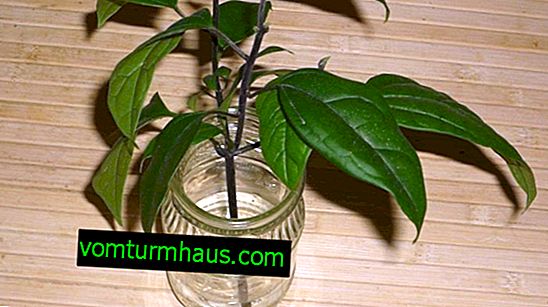
Seed cultivation
Sow seeds for reproduction begin in late February - early March.
Growing is as follows:
- Seeds are sown in a substrate. The substrate should consist of sand, turf land and peat.
- Sown seeds are placed in greenhouse conditions, maintaining good lighting in the room.
- Sunrises should appear on average in 6–8 weeks. When the sunrise has at least 4 leaves, it is transplanted into separate containers.
- After rooting and growth, sprouts are accustomed to the conditions for caring for adult clerodendrum.
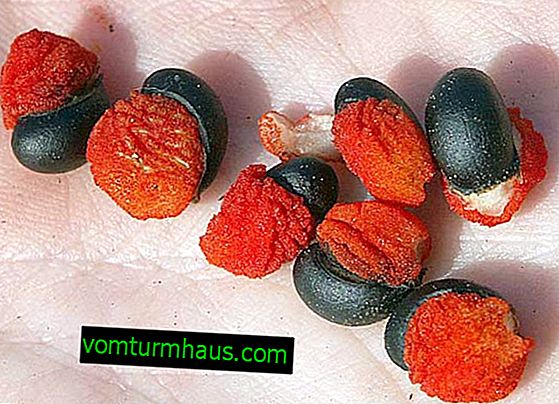
Growing difficulties
Most of the difficulties in growing occurs if you do not adhere to the rules for caring for the plant. In addition, there are diseases and pests that can cause harm to clerodendrum.
Why does not bloom
One of the most common difficulties in growing Thompson's maple dendrum, which beginner growers encounter, is the lack of flowering. The reason for this phenomenon is non-compliance with the basic rules of care.
Consider some violations and remedies:
- Improper care during rest . In order to make your clerodendrum spring bloom, in winter you need to help it relax and strengthen. To do this, when the flowering ends and the leaves begin to fall, the amount of watering is reduced and the plant is transferred to a cool room with a temperature of no more than +15 ° C for 6–8 weeks. As soon as the flower begins to start new shoots, it is necessary to increase the number of waterings, cut, transplant it and transfer it to a warm room.
Did you know? In some European countries, Thompson's Clodendrum is called the vine of a bleeding heart, due to the fact that white bracts resemble a heart in shape, and red flowers - droplets of blood.
- Lack of lighting . If there is not enough natural light, for example, when the windows of the room in which the clerodendrum is located are facing north, then additional illumination must be used.
Disease
Clodendrum can be sick due to violations of the rules of care: insufficient or excessive amount of moisture, lighting, improper room temperature.
The cause of yellowed leaves may be a lack of moisture or irrigation with hard (not settled) water. In cases when the leaves begin to become covered with dark spots, it is possible that direct sunlight falls on them, and it is necessary to change the location of the liana.

Pests
Consider the pests that can attack the plant, and ways to combat them:
- butterfly whitefly . This insect places its larvae on the leaves, due to which the leaves change shape and fall off. In order to get rid of this pest, the leaves are treated with an insecticide every 3 days for 2 weeks. Leaves containing whitefly larvae must be destroyed;
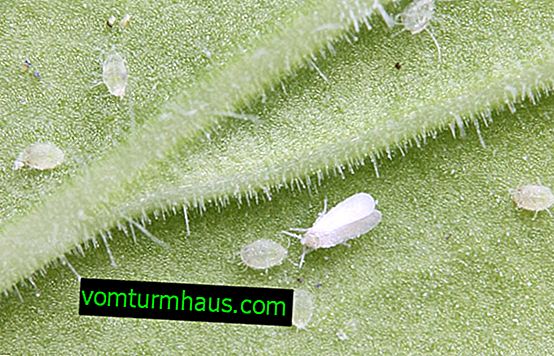
- aphids . Symptoms of the attack of this pest are poor growth, deformation, wilting of the plant. Methods of control are similar to methods of controlling whiteflies. Also, flower leaves can be treated not with an insecticide, but with a soap solution;
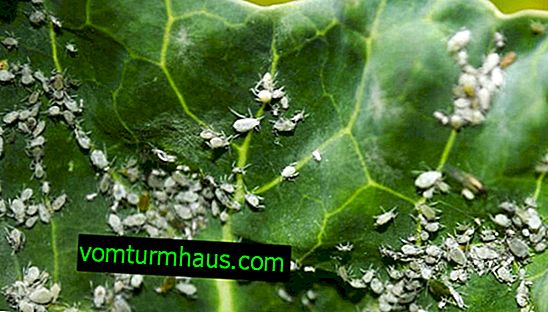
- scale shield . The attack of this pest is indicated by yellow spots on the leaves, their fall. To destroy the scale, the leaves are treated with a soap solution every 3 days.
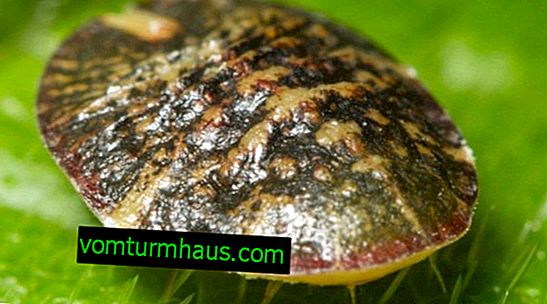
Omens and superstition
Clerodendrum is called the tree of fate, its history is shrouded in signs and superstitions. Some of them say that a plant brings luck, happiness and wealth to its owner, some, on the contrary, promise a grief and illness from a flower.
There is a popular sign that a woman who grows Thompson's clerodendrum at home is doomed to loneliness and will never marry. How much this is true, how much not - you decide.

Clerodendrum Thompson is a popular plant with unusually beautiful and long flowering. It is quite demanding in care, but the beauty that it gives in return exceeds all expectations.








